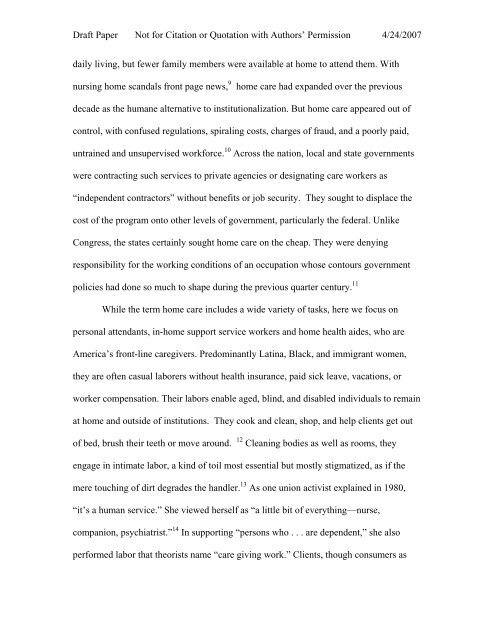Organizing Home Care: - School of Social Service Administration
Organizing Home Care: - School of Social Service Administration
Organizing Home Care: - School of Social Service Administration
You also want an ePaper? Increase the reach of your titles
YUMPU automatically turns print PDFs into web optimized ePapers that Google loves.
Draft Paper Not for Citation or Quotation with Authors’ Permission 4/24/2007<br />
daily living, but fewer family members were available at home to attend them. With<br />
nursing home scandals front page news, 9<br />
home care had expanded over the previous<br />
decade as the humane alternative to institutionalization. But home care appeared out <strong>of</strong><br />
control, with confused regulations, spiraling costs, charges <strong>of</strong> fraud, and a poorly paid,<br />
untrained and unsupervised workforce. 10 Across the nation, local and state governments<br />
were contracting such services to private agencies or designating care workers as<br />
“independent contractors” without benefits or job security. They sought to displace the<br />
cost <strong>of</strong> the program onto other levels <strong>of</strong> government, particularly the federal. Unlike<br />
Congress, the states certainly sought home care on the cheap. They were denying<br />
responsibility for the working conditions <strong>of</strong> an occupation whose contours government<br />
policies had done so much to shape during the previous quarter century. 11<br />
While the term home care includes a wide variety <strong>of</strong> tasks, here we focus on<br />
personal attendants, in-home support service workers and home health aides, who are<br />
America’s front-line caregivers. Predominantly Latina, Black, and immigrant women,<br />
they are <strong>of</strong>ten casual laborers without health insurance, paid sick leave, vacations, or<br />
worker compensation. Their labors enable aged, blind, and disabled individuals to remain<br />
at home and outside <strong>of</strong> institutions. They cook and clean, shop, and help clients get out<br />
<strong>of</strong> bed, brush their teeth or move around. 12 Cleaning bodies as well as rooms, they<br />
engage in intimate labor, a kind <strong>of</strong> toil most essential but mostly stigmatized, as if the<br />
mere touching <strong>of</strong> dirt degrades the handler. 13 As one union activist explained in 1980,<br />
“it’s a human service.” She viewed herself as “a little bit <strong>of</strong> everything—nurse,<br />
companion, psychiatrist.” 14 In supporting “persons who . . . are dependent,” she also<br />
performed labor that theorists name “care giving work.” Clients, though consumers as
















